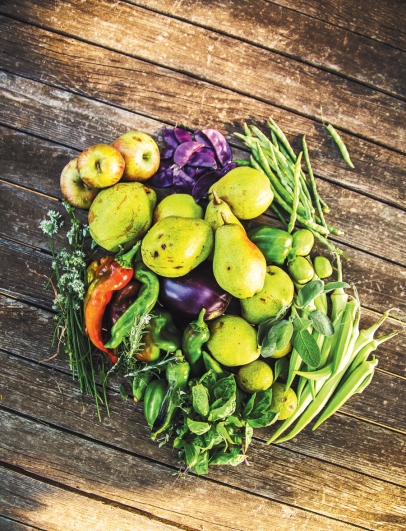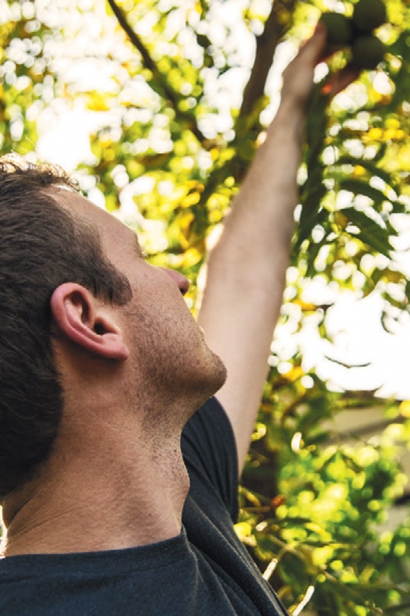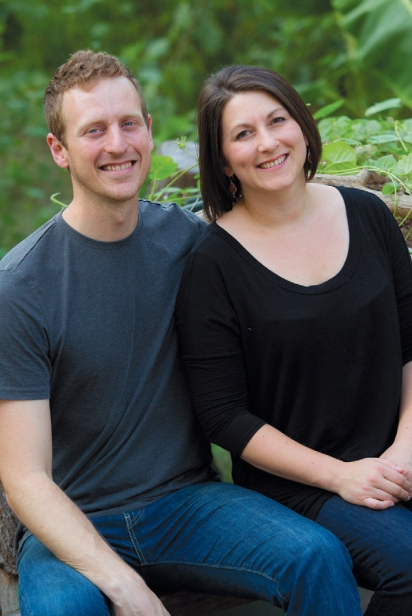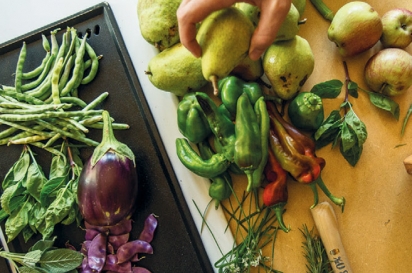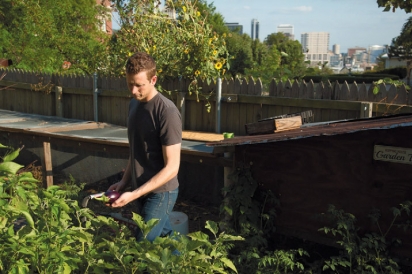A Hunger for Home-Grown
Nathan Pickard’s Backyard Food Forest
For one month, Nathan Pickard foraged all his meals from his backyard. He’s what you might call an experimental conservationist. When it comes to environmental stewardship, most of us are content to talk the talk and leave the hard work of preserving the environment to someone else. Nathan, ever on a quest to minimize his personal impact on the planet, prefers to walk the walk.
He and I live in the same neighborhood near downtown Tulsa. Legend has it, our neighborhood was once described as a cult by a Realtor who was assisting a couple in their home search. We’re not a cult. But if we were, Nathan would probably be our leader. Calm and soft-spoken, passionate and hardworking, Nathan leads quietly, by example.
Though he and his wife, Kristin, own a 3,600-square-foot home, they live in an attic studio apartment with their two young children. The other rooms in the house are rented to students and Teach for America corps members. The family practices extreme personal finance. At one point when I visited them, a wall-sized graph tracked their expenditures. Nathan and I would often meet for lunch when we led the neighborhood association, but I was sometimes the only one eating. Nathan’s dietary experiment, the Warrior Diet, involved fasting for 20 hours of the day, feasting the other four. Nathan walks or cycles to work. In January, he and Kristin removed the battery from their car, braving snow and ice by bike for a month-long experiment. And in June, Nathan ate exclusively from his backyard farm.
Hopping House Farms, also known as the Pickard’s backyard, is a ⅔-acre urban homestead. Carefully designed as a seven-layer permaculture food forest, a 20-foot-tall pecan tree serves as the uppermost layer, root vegetables the base. In between, all manner of food-producing native trees, bushes, plants and herbs. A narrow, winding path cuts through the farm. Standing in the thick of it, greenery on all sides, fresh fruits and fragrant herbs all around, it feels like a magical forest and it’s easy to forget you’re on a tiny urban lot sandwiched between North Denver Avenue and the L.L. Tisdale Parkway.
“I would just like walk through this route and just pick whatever I saw,” Nathan says of his experiment.
He casually journaled his experience on his Restoration Collective Facebook page, logging each meal. A typical entry reads: June 11 Sunday: In the morning, I went out and harvested my food for the day. Grabbed lamb’s quarters, eggs, rosemary, kale, cabbage, fennel, thyme, smartweed, oregano, cilantro, radish seed pods, onions and garlic. For breakfast, I fried most of those things together with two eggs. For lunch, I fried most of those things together with a sourdough cake. For dinner, I fried up a couple eggs. I snacked on dried plums and kale chips throughout the day.
Did he feel like he was going to starve to death on this diet, I wondered?
He and I are of similar build, tall and slender. I recently attempted to complete the Whole30 diet but, after 6.5 days in a physically painful state of hunger, I suffered a crisis of the mind. Twenty minutes after devouring a plate piled high with potatoes, eggs and vegetables, I was starving again. My mind sharpened by hunger, I contemplated the pros and cons of choosing hunger in the land of plenty.
“That was definitely one of the biggest things,” Nathan reflected, “Actually experiencing hunger. Like true hunger. I remember thinking, ‘Wow, this is probably what a hunter-gatherer would feel like.’ This motivation to get out and harvest out of hunger.”
Lacking Nathan’s mental fortitude, I ultimately caved, shortening my Whole30 to a Whole6.5. He persevered through the hunger, though, and insists that the first six or seven days were the hardest. Around day seven, Nathan began to identify what was missing most from his diet. Not protein, as one might guess. Eggs provided the protein he needed. Not bread. He harvested and ground his own wheat, adding it to a sourdough starter to make naan-bread style dough.
“There’s a lot more protein than people think in plants and our diets are way too high in protein anyway. I hadn’t even thought about the fats and that’s what really got me,” Nathan says.
With no sources of fat in his backyard, Nathan was missing a critical component of a balanced diet. After trying, and failing, to make his own oil from sunflower seeds, he decided he would make an exception and import some oil. A fellow permaculture friend offered him some lard from a wild boar that had been harvested in Oklahoma and he used this for his cooking through the remainder of the month, satisfied that it was a local product.
When his 30 days were up, Nathan was eager to re-introduce the foods he had been missing but he found that nothing was as good as he remembered. As he continued to eat almost exclusively from the backyard through July and into August, he recounted a recent trip taken to Chicago in which he experienced a new kind of hunger.
“I felt like I was starved over there. Even though they have so many awesome restaurants … I was so glad to be back home and to be able to eat real food.”
Nathan’s primary goal with his experiment was personal: to assess whether he could produce enough food for himself and his family on his small-scale farm. Lessons learned from these short-term experiments help the Pickard’s plan for the future and move towards a more sustainable lifestyle. Significant lifestyle changes don’t come easy. The Pickards enjoy the challenge of putting themselves in a situation in which they are forced to adapt.
In the long term, Nathan wonders if his experiment could be replicated at neighborhood level. Between the Tisdale Food Forest, the community garden, the market farm at Emerson Elementary and Nathan’s newest project, the Latimer Street Grocery, the neighborhood does seem poised to benefit from a hyper-local food system.
“Could those actually be sources for a large percentage of all the neighborhood’s diet?” Nathan wonders, “That was probably my big goal. To see if it could be done, if it was healthy, and then could it be ramped up?”
Our neighborhood is not a cult, but maybe we do have a touch of the hippie commune in us.
For more information about Nathan’s local conservation efforts, visit the Restoration Collective website at thejoin.org.


